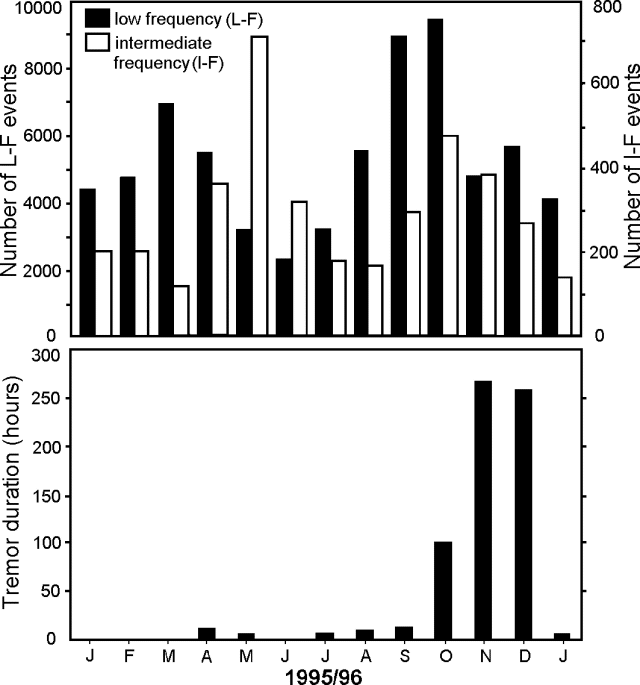Report on Poas (Costa Rica) — January 1996
Bulletin of the Global Volcanism Network, vol. 21, no. 1 (January 1996)
Managing Editor: Richard Wunderman.
Poas (Costa Rica) Seismically active with new fumaroles and some cross-crater deformation
Please cite this report as:
Global Volcanism Program, 1996. Report on Poas (Costa Rica) (Wunderman, R., ed.). Bulletin of the Global Volcanism Network, 21:1. Smithsonian Institution. https://doi.org/10.5479/si.GVP.BGVN199601-345040
Poas
Costa Rica
10.2°N, 84.233°W; summit elev. 2697 m
All times are local (unless otherwise noted)
When visited during January, the surface of the turquoise-green crater lake had risen 45 cm with respect to its December level. At the dome's N margin a small bubbling spring discharged relatively clear water. Lake water measured at the shoreline near the spring had a temperature of 29°C and on the N shore, a temperature of 27°C. The ongoing collapse of the N wall continued, as did reports of sulfur odors at the park entrance station, ~1 km away. Within the crater a small landslide had partially covered the W terrace and local fumaroles there, but fumaroles had migrated to the NW terrace where escaping gases made loud noises. SW-terrace fumaroles also remained active.
The SE-SW portion of the crater wall contained new fumaroles. These chiefly had temperatures of 73-91°C, with the maximum fumarole temperature, 94°C, found along the S wall. During the January visit, the intracrater cone displayed an increased number of gas emission points. Although the majority were inaccessible, gas columns emanating from the crater margins gave temperatures of 94°C.
During 1995, two distance-survey lines across the active crater underwent an expansion of 19.5 ppm. During the same interval, the distance-survey network outside the crater and the tilt network both lacked significant changes.
During December 1995 and January 1996, the total number of seismic events was relatively high, 5,960 and 4,187, respectively (figure 60). These events were predominantly of low frequency. During December and January, tremor registered for a total of 259 and 6 hours, respectively.
Geological Summary. The broad vegetated edifice of Poás, one of the most active volcanoes of Costa Rica, contains three craters along a N-S line. The frequently visited multi-hued summit crater lakes of the basaltic-to-dacitic volcano are easily accessible by vehicle from the nearby capital city of San José. A N-S-trending fissure cutting the complex stratovolcano extends to the lower N flank, where it has produced the Congo stratovolcano and several lake-filled maars. The southernmost of the two summit crater lakes, Botos, last erupted about 7,500 years ago. The more prominent geothermally heated northern lake, Laguna Caliente, is one of the world's most acidic natural lakes, with a pH of near zero. It has been the site of frequent phreatic and phreatomagmatic eruptions since an eruption was reported in 1828. Eruptions often include geyser-like ejections of crater-lake water.
Information Contacts: Rodolfo Van der Laat, Vilma Barboza, Erick Fernández, Jorge Barquero, Franklin de Obaldia, Tomás Marino, and Rodrigo Sáenz, Observatorio Vulcanológico y Sismológico de Costa Rica, Universidad Nacional (OVSICORI-UNA).


